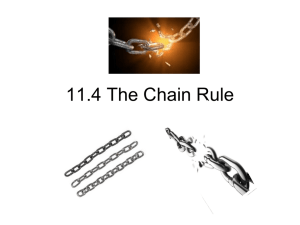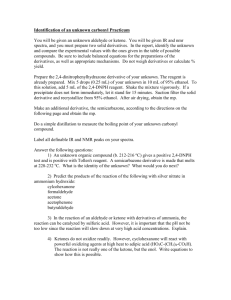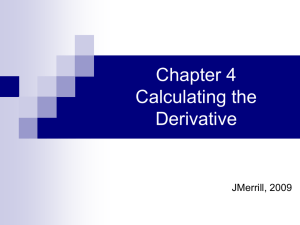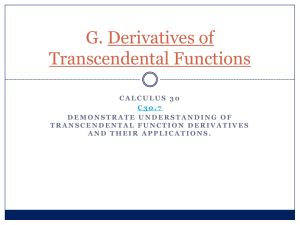Lesson 11.4: The Chain Rule
advertisement
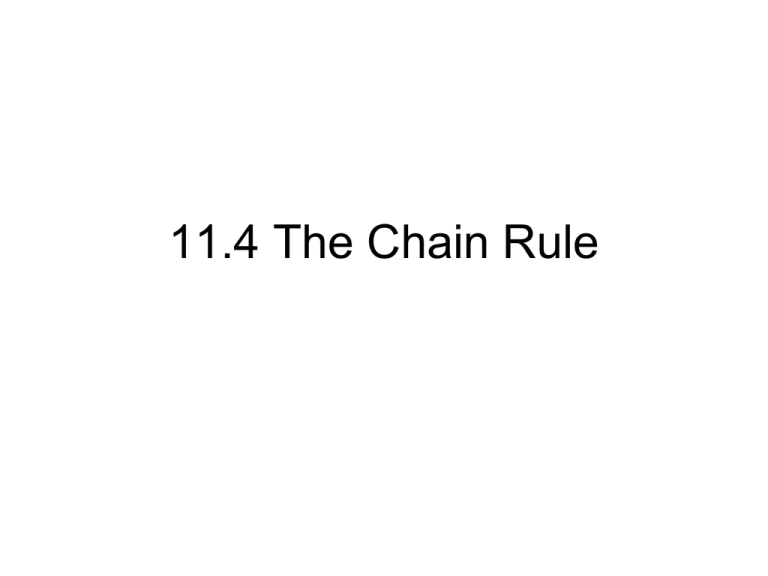
11.4 The Chain Rule Composite Functions Definition: A function m is a composite of functions f and g if m(x) = f [g(x)] The domain of m is the set of all numbers x such that x is in the domain of g and g(x) is in the domain of f. Example 1 Given f(u) = 2u and g(x) = ex Find f [g(x)] and g [f(u)] f [g(x)] = f (ex) substitute g(x) for ex = 2(ex) plug ex into function f(u) = 2ex g [f(u)] = g (2u) substitute f(u) for 2u = e2u plug 2u into function g(x) Example 2 Write each function as a composite of two simpler functions A) Y = 50 e-2x g(x) = -2x and B) y 3 1 x f(u) = 50 eu 3 g ( x) 1 x 3 and f (u ) 3 u C) Write y as a composite of two simpler functions y = (2x + 1)100 g(x) = 2x + 1 and f(u) = u 100 How do we find the derivative of a composite function such as the one above? What is the derivative of (2x + 1)100 Let’s investigate on the next slide! Find the derivative of (2x + 1)2, (2x + 1)3, (2x + 1)4 and (2x + 1)100 Use the product rule: F(x) = (2x + 1)2 = (2x + 1) (2x + 1) F’(x) = (2)(2x+1) + (2)(2x+1) = 4(2x+1) F(x) = (2x + 1)3 = (2x + 1) (2x + 1)2 = (2x+1)(4x2 + 4x +1) F’(x) = (2)(4x2 + 4x +1) + (8x + 4)(2x + 1) = 2 (2x+1)2 + 4(2x+1)(2x+1) = 2 (2x+1)2 + 4(2x+1)(2x+1) = 2 (2x+1)2 + 4(2x+1)2 = 6 (2x+1)2 Try (2x + 1)4 you should find out that f’(x) = 8 (2x+1)3 Look at the relationship between f(x) and f’(x), do you agree that the derivative of (2x + 1)100 is 200 (2x+1)99 ? f(x) f’(x) (2x + 1)2 4(2x+1) = 2(2x+1) · 2 (2x + 1)3 6(2x+1)2 = 3(2x+1)2 · 2 (2x + 1)4 8(2x+1)3 = 4(2x+1)3 · 2 (2x + 1)100 200(2x+1)99 = 100(2x+1)99 · 2 Any composite function [g(x)] n n·[g(x)]n-1 · g’(x) Generalized Power Rule What we have seen is an example of the generalized power rule: If u is a function of x, then d dx u nu n n 1 du dx Chain Rule We have used the generalized power rule to find derivatives of composite functions of the form f (g(x)) where f (u) = un is a power function. But what if f is not a power function? It is a more general rule, the chain rule, that enables us to compute the derivatives of many composite functions of the form f(g(x)). Chain Rule: If y = f (u) and u = g(x) define the composite function y = m(x) = f [g(x)], then dy dy du , dx du dx provided dy du and du exist . dx Or m’(x) = f’[g(x)] g’(x) provided that f’[g(x) and g’(x) exist Example 3 Find the indicated derivatives A) h’(x) if h(x) = (5x + 2)3 h’(x) = 3 (5x + 2)2 (5x+2)’ = 3 (5x + 2)2 (5) =15 (5x + 2)2 B) y’ if y = (x4 – 5)5 y’= 5(x4 – 5)4 (x4 – 5)’ = 5(x4 – 5)4 (4x3) = 20x3 (x4 – 5)4 Example 3 Find the indicated derivatives C) D) d 1 dt t 4 dg 2 2 d dt t 2 4 2 2 t 4 2 3 ( 2t ) 4t t 2 4 1 if g (w) 4w (4 w) 2 dw 1 dg dw 1 2 4 w 1 2 1 1 2 4 w 2 3 Example 4 Find dy/du, du/dx, and dy/dx (express dy/dx as a function of x) A) y = u-5 and u = 2x3 + 4 dy 5u 6 du du 5 u 6x 6 2 dx dy dx dy du du dx 5 u 6 2 (6 x ) 30 x u The problem above can be solved by taking the derivative of y = (2x3 + 4) -5 6 2 30 x 2 (2 x 4) 3 6 Example 4 (continue) Find dy/du, du/dx, and dy/dx (express dy/dx as a function of x) B) y = eu and u = 3x4 + 6 dy e u du du 12 x 3 dx dy dx dy du du dx e (12 x ) 12 x e u 3 3 u 12 x e 3 4 3x 6 This problem can be solved by taking the derivative of y e 4 3x 6 Example 5 Find dy/du, du/dx, and dy/dx (express dy/dx as a function of x) C) y = ln u and u = x2 + 9x + 4 dy du du 1 u 2x 9 dx dy dx dy du du dx 1 u (2 x 9) 2x 9 x 9x 4 2 This problem can be solved by taking the derivative of y = ln (x2 + 9x + 4) The chain rule can be extended to compositions of three or more functions. Given: Y = f(w), w = g(u), and u = h(x) Then dy dy dw du dx dw du dx Example 6 y = h(x) = [ ln(1 + ex) ]3 find dy/dx Let y = w 3, w = ln u, and u = 1 + ex then dy dy dw du dx dw du dx dy dx 3w 2 1 e x 3 (ln u ) 2 1 x u u 3[ln( 1 e )] x x 1 e x 1 2 3 e [ln( 1 e )] x e 1 e 2 x e x Example 6 (continue) y = h(x) = [ ln(1 + ex) ]3 find dy/dx Another way dy dx Derivative of the outside function 1 e (e ) x x The derivative of the function inside the [ ] 3 e [ln( 1 e )] x 1 2 3 ln( 1 e ) x x 1 e x 2 Derivative of the function inside ( ) Examples for the Power Rule Chain rule terms are marked: y x , y' ? 5 y (2 x) , y ' ? 5 y (2 x ) , y ' ? 3 5 y ( 2 x 1) , y ' ? 5 y (e ) , y ' ? x 5 y (ln x ) , y ' ? 5 Compare with the next slide Examples for the Power Rule Chain rule terms are marked: y x , y' 5x 5 4 y ( 2 x ) , y ' 5 ( 2 x ) ( 2 ) 160 x 5 4 4 y ( 2 x ) , y ' 5 ( 2 x ) ( 6 x ) 480 x 3 5 3 4 2 14 y ( 2 x 1) , y ' 5 ( 2 x 1) ( 2 ) 10 ( 2 x 1) 5 4 y (e ) , y ' 5(e ) (e ) 5e x 5 x 4 x 5x y (ln x ) , y ' 5 (ln x ) (1 / x ) 5 4 5 (ln x ) x 4 4 Examples for Exponential Derivatives d e u dx y e , y' ? 3x ye 3 x 1 ye 4 x 3 x5 ye ln x 2 , y' ? , y' ? , y' ? Compare with the next slide e u du dx Examples for Exponential Derivatives d e e u u dx dx y e , y' e 3x ye 3 x 1 ye 4 x 3 x5 ye 2 ln x du 3x , y' e (3) 3e 3 x 1 (3) 3e , y' e , y' e ln x 3x 2 4 x 3 x5 1 ( ) x e 3 x 1 (8 x 3 ) ln x x x 1 x Property of ln Examples for Logarithmic Derivatives d 1 du ln u dx u dx y ln( 4 x ), y' ? y ln( 4 x 1), y ln( x ), 2 y' ? y' ? y ln( x 2 x 4 ), 2 Compare with the next slide y' ? Examples for Logarithmic Derivatives d 1 du ln u dx u dx y ln( 4 x ), 1 y' 4 4x y ln( 4 x 1), y ln( x ), 2 y' y' 1 x y ln( x 2 x 4 ), 2 2 1 x 1 4x 1 4 (2 x) 4 4x 1 2 x y' 1 x 2x 4 2 (2 x 2) 2x 2 x 2x 4 2
